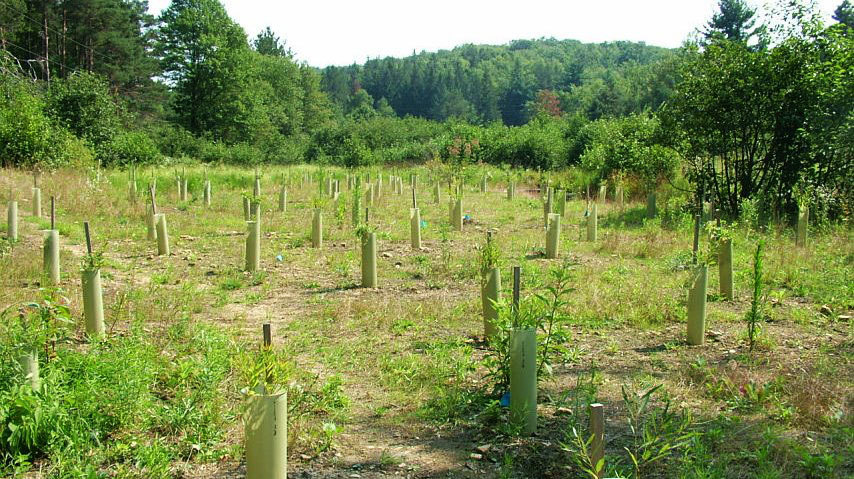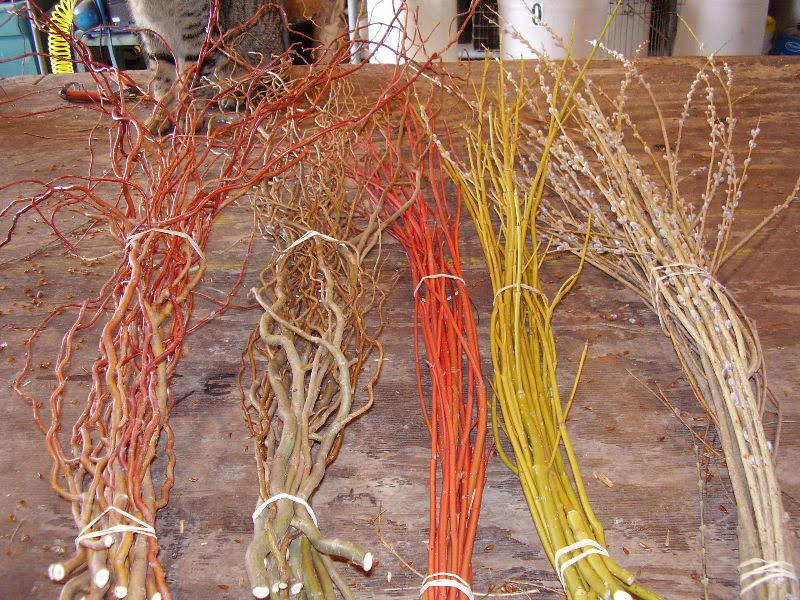This article first appeared in Yale Environment 360 and is reprinted with permission.
By Janet Marinelli
More than 100,000 miles of U.S. rivers and streams are polluted by nitrogen and phosphorus, much of it from agricultural runoff. In Pennsylvania, an innovative program is showing farmers how to plant cash crops in buffer zones to help stabilize stream banks and clean up waterways.
In Chester County, Pennsylvania, about 40 miles northwest of Philadelphia, Beaver Run carves a triangular piece of bottomland as it turns east to join French Creek. A gnarled old American sycamore grows in the narrow fringe of native forest bordering the stream. On a cold, gray winter’s day, agroforester Austin Unruh pulls on a woolen beanie and points out the variety of saplings poking through the straw-colored carpet of dormant grasses beyond the thin band of forest.
“Over there are American persimmons and pawpaws,” he says, identifying two of the native fruit-bearing trees he planted on the 3-acre corner of land. Scattered among them are ornamental natives such as red-twig dogwood and willows, which fetch a good price in the floral trade, he explained. With a state-funded grant from the nonprofit Stroud Water Research Center in Avondale, Pennsylvania, Unruh leased the land from Lundale Farm to demonstrate how agroforestry can be employed to create a new kind of pollution-fighting landscape called a “working buffer.”
A few hundred years ago, forests grew naturally along waterways in the eastern United States, but many have been razed to make way for towns, cities, cattle, and crops. Today, strips of streamside land replanted with native floodplain trees and shrubs, called riparian forest buffers, are essential to the health of creeks and rivers. These buffers help stabilize stream banks and decrease flooding while trapping and filtering pollutants that would otherwise end up in local waterways. Until recently, however, restoring a streamside buffer in rural areas meant taking farmland out of production.

Agroforester Austin Unruh in the buffer he created alongside Beaver Run. Photo courtesy of Eric Hurlock
Four years ago, with its push to create riparian forest buffers lagging far behind mandated targets, Pennsylvania established an innovative grant program to encourage farmers and landowners to plant working buffers that can yield cash crops. Unruh, who was working on a master’s degree in agroforestry, leapt at the opportunity. In addition to planting the Lundale Farm buffer, he founded Crow and Berry Land Management to help farmers in the Delaware and Chesapeake basins, the two major watersheds in eastern Pennsylvania, take advantage of state and private funding to design, plant, and maintain working buffers on their own lands.
From Lundale Farm, French Creek meanders southeast to the Schuylkill River, which continues on a winding course down to Philadelphia, where it joins the Delaware River. Stretching 330 densely populated miles from New York’s Catskill Mountains to the Atlantic Ocean, the Delaware is the lifeblood of the region, providing drinking water for more than 13 million people, including residents of New York City. The river and its web of tributaries also sustain countless orchards, dairy farms, corn and soybean fields, and nurseries. According to the Pennsylvania Association of Conservation Districts, almost 27 percent of the watershed is agricultural, a mixture of cropland and pasture.
As storm water runs off of farmland, it can wash away not only pesticides and soil but also nutrients such as nitrogen and phosphorus from commercial fertilizers and manure. These pollutants enter upstream waters, such as Beaver Run, and end up in larger water bodies like the Delaware, degrading water quality by promoting algal blooms that can harm aquatic species by depriving them of oxygen. They also create toxins and compounds in surface and groundwater supplies that can be harmful to human health.
The problem extends well beyond the Delaware watershed. According to the Environmental Protection Agency (EPA), more than 100,000 miles of U.S. rivers and streams have poor water quality because of nitrogen and phosphorus pollution, which the agency calls “one of America’s most widespread, costly, and challenging environmental problems.”
“Riparian forest buffers are a primary method that Pennsylvania is looking at for reducing its water quality problems,” says one official.
Riparian buffers not only help filter out fertilizers and other pollution. By shading streams and producing woody debris, they enhance aquatic habitat and provide food, cover, and nesting sites for birds and other animals. They also sequester carbon. The wider the buffer, the greater its benefits.
“Riparian forest buffers are a primary method that Pennsylvania is looking at for reducing its water quality problems,” says Tracey Coulter, agroforestry coordinator at the state Department of Conservation and Natural Resources (DCNR). For example, the state is responsible for fully 65 percent of the nitrogen and phosphorus polluting the Chesapeake Bay. As part of a newly updated Watershed Implementation Plan that lays out how the five states in the Chesapeake Basin intend to reduce the nutrients flowing into the bay to levels required by the EPA, Pennsylvania has committed to planting 85,650 new acres of riparian forest buffers by 2025. “It’s a massive goal, especially compared to what the rate of implementation has been lately,” says Lamonte Garber, watershed restoration coordinator at the Stroud Water Research Center.
For the past two decades, most buffers have been financed by the Conservation Reserve Enhancement Program (CREP), a federal initiative that covers 50 percent of the cost of planting riparian forest buffers at least 35 feet wide, and 100 percent for buffers 50 feet or wider. The farmers also receive a land rental check for 10 to 15 years. In return, farmers are prohibited from generating income from the buffers. CREP also requires that farmers maintain the buffers for the first three to five years while the plantings become established.
But participation in CREP has lagged, in part because farmers are reluctant to retire cropland. “Non-productive land is an anathema for farmers,” says Coulter. Many Pennsylvania farms are small, family enterprises, and in the words of Chris Kieran, senior associate of the William Penn Foundation’s watershed protection program, “the smaller the farm, the more valuable each individual acre is to the overall operation.” Many farmers also balk at the hassle involved in dealing with the federal government. In addition, most Amish and Mennonite farmers, who work a good deal of acreage in Pennsylvania, don’t believe in taking money from the government.

A recently planted riparian buffer in Dayton, Pennsylvania. The saplings are in tree sleeves to protect against deer and rodent damage. Photo courtesy of Clearwater Conservancy
The problem is compounded by the fact that many of the early buffers created under CREP suffered from a lack of maintenance. If there’s nothing to harvest in the buffer, maintenance often takes a back seat to other pressing farm tasks, says Coulter. “We need a way to make the buffers important to farmers,” she says.
Pennsylvania sees working buffers as a compromise that protects water quality while allowing farmers not participating in CREP to earn a living from their land. A 1998 study by University of Maryland researchers concluded that buffers can gross nearly $25,000 per acre annually. According to Jeremy Kaufman, chief operating officer of Propagate Ventures, which works with farmers to make buffers and other forms of agroforestry economically viable, “fruit and nut crops yield a much higher return per acre than a row crop operation.”
As envisioned by Pennsylvania officials, working buffers consist of three zones. While conventional forest buffers must extend at least 35 feet from the water’s edge, the strip of native woodland that comprises zone one of a working buffer can be just 15 feet wide. The principle objective of this zone is to stabilize the bank with tree roots and enhance wildlife habitat.
The second zone, which extends 15 to 35 feet from the water, is planted with trees and shrubs that can tolerate periodic flooding. In addition to slowing floodwater and taking up nutrients, this zone is designed to provide products for profit or personal use. For example, black walnut, American hazelnut, pawpaw, American persimmon, and common elderberry can tolerate the conditions in this area and yield salable fruits and nuts. To minimize soil disturbance, only hand harvesting is permitted in zone two.
Coulter calls zone three, which is adjacent to crop fields or grazing lands, “the most commercial part of the buffer.” In this zone, mechanical harvesting is allowed. Candidate crops require slightly drier soils, such as blueberry and black raspberry, as well as decorative “woody florals” such as curly willow, wild hydrangea, pussy willow, and winterberry holly.
To date, most buffers have been established by small landowners philosophically committed to land stewardship.
In addition to edible fruits, nuts, mushrooms, and cut stems for the floral trade, advocates say, working buffers with beehives can produce income from honey. Depending on the location, working buffers can also yield high-value medicinal plants like ginseng and black cohosh. Mulberries and other trees can provide fodder for livestock, an attraction for dairy farmers.
How many farmers and landowners can be enticed to create working buffers remains to be seen. To date, most have been established by small landowners philosophically committed to land stewardship. This has fueled concerns that the concept could remain a cottage industry and never really spread across the landscape at a scale that would make a real difference for water quality.
“My hunch is that the number is going to be small, less than 10 percent of landowners out there who have significant stream frontage,” says Garber of the Stroud Center. “It may be an incentive for small-scale niche farmers who may have 5, 10, or 20 acres,” he says, but not for the majority of “production farmers” such as dairy operations and corn and soybean growers. “Most of those farmers have their hands full with their existing farm enterprise,” says Garber.
Some researchers at the Stroud Center, which in recent decades has done much of the research on the effectiveness of conventional riparian forest buffers, also worry that working buffers may lose some pollution-reduction power when the native forest portion is downsized and replaced with tree and shrub crops. Until proven otherwise, Garber says policymakers should not be tempted by the current enthusiasm for working buffers to stop funding and improving CREP and other traditional buffer programs.

Woody florals such as dogwood and willows can be grown in buffers and marketed to the floral trade. Photo courtesy of Illinois Willows
A growing number of entrepreneurs like Unruh and Kaufman are leading the transition to low-impact “regenerative” farming that integrates trees and shrubs with traditional crops, not only in working buffers but also pastures, windbreaks, and narrow, widely spaced rows of trees that produce nuts and other valuable products in the midst of traditional crops, a technique called alley cropping. However, these forms of agroforestry are unfamiliar to most American farmers. Another impediment to the adoption of working buffers as envisioned by the state is that hand harvesting is necessary, making them more labor-intensive than crops like corn and soybeans that can be harvested mechanically.
What’s more, you can’t just leave a load of persimmons at the local grain elevator. The marketing and distribution infrastructure for such products does not yet exist. “We’re trying to work out strategies for these things,” Coulter says. Among the solutions under discussion are co-ops, such as the Midwest Elderberry Cooperative in Minnesota and a woody floral co-op in Nebraska.
Most farmers are used to thinking in annual cycles, says Kaufman, so “the 20- or 30-year investment entailed with working buffers can be a challenge for them.” To allay their concerns, Propagate Ventures brings a variety of potential partners to the table with farmers willing to consider creating a working buffer. Among them are ecologically minded investors, including companies that can market their support of low-impact agriculture on their product labels. “Farmers need to know that a buyer will be available” when the tree crops begin to bear fruit, says Kaufman. Putting together the right kind of investment arrangements, purchase and lease agreements, and management and maintenance contracts is critical to making this kind of farming work, Kaufman says.
If working buffers are to succeed, they must incorporate the needs of individual farmer, says one expert.
According to Unruh, states and the federal government have employed a “cookie-cutter approach” to streamside buffers, concerned only with improving water quality. If working buffers are to succeed, he says, they must incorporate the needs of individual farmers as well. “Taking a holistic approach, looking at the whole farm and not just the buffer is key,” says Kaufman. “So someone accustomed to growing grain might be more interested in a hay-production crop between rows of trees than dealing with elderberries or other shrub fruits,” he says.
This spring, Propagate Ventures and the Stroud Center will be identifying three farms willing to pilot working buffers and to work out business models for them. Meanwhile, the Pennsylvania Infrastructure Investment Authority (PENNVEST), a partner in the state’s grant program for working buffers, is keeping track of the costs the buffers accrue and the income they generate. The authority, which traditionally has managed revolving loans for sewage, storm water, and drinking water projects, hopes to do the same for working buffers. But right now there is little data to support a business plan and complete data from the farms they have funded won’t be available for three or four years, says PENNVEST executive director Brion Johnson.
“The real long-term sustainable solution,” he says, “is to move away from just grants to a low-interest, revolving loan program that can support these buffers 20, 30, 40 years into the future.”



